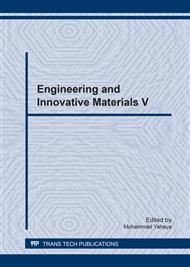p.184
p.191
p.195
p.201
p.209
p.215
p.221
p.229
p.234
Production and Characterisation of Single and Mixed Activated Carbons from Coconut Shell and Rubber Seed Pericarp Using Microwave-Induced Chemical Activating Agent
Abstract:
Activated carbon from biomass namely coconut shell (CS-AC), rubber seed pericarp(RSP-AC) and their mixed blend (50:50 w/w) coconut shell-rubber seed pericarp activated carbon(CSRSP-AC) were successfully produced by using ZnCl2 as chemical activating agent viamicrowave irradiation heating system. Activation process was performed in commercial microwaveoven at power of 600W for 20 min by using 30%, 40% and 50% of ZnCl2 concentrations. Theactivated carbon was characterized according to BET surface morphology, iodine number andpercentage of MB removal. The results showed that the mixed CSRSP-AC produced the highestsurface area of 584.68 mg2/g with comparison to single CS-AC and RSP-AC at 445.9 mg2/g and462.5 mg2/g respectively. Although CSRSP-AC has the highest surface area and pore volumedevelopment, RSP-AC was found to have the highest iodine number, with the opposite trend beingobserved with MB removal indicating that RSP-AC has the highest adsorptive capacity among thethree activated carbons. The iodine number value and percentages of MB removal increased as theZnCl2 concentration increase from 30% to 50%. These findings revealed that activated carbonproduced from mixed blend of coconut shell and rubber seed pericarp has almost similarcharacteristics to their respective activated carbon derived from single individual biomass.
Info:
Periodical:
Pages:
209-214
Citation:
Online since:
March 2017
Price:
Сopyright:
© 2017 Trans Tech Publications Ltd. All Rights Reserved
Share:
Citation:


